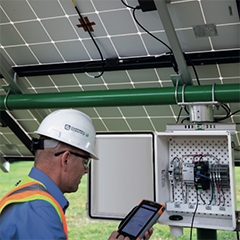PES had a very thought-provoking discussion with Matt Perry, who is a Technical Product Manager and co-founding member of the Renewable Energy Group, as well as the Chair of the Sustainability Committee, at Campbell Scientific, Inc. He also serves on the Logan City Renewable Energy and Conservation Advisory Board. Outside of work, Matt spends time with family and friends, traveling in pursuit of experience and adventure through climbing, time on (and off!) the trail, skiing, and the beach.
PES: Why are meteorological measurements so critical in understanding the performance of
solar farms?
Matt Perry: There are two fundamental questions that require quality meteorological data to answer: ‘how much solar radiation reaches the surface of the PV modules’ and ‘how much of this solar radiation is converted into electricity for a given module configuration’?
It may seem trivial to quantify with high accuracy and low uncertainty the amount of solar radiation that reaches the PV module surface given recent advancements in satellite and radiometric technologies; however, one must consider the seemingly random nature of solar radiation.
The uncertainty associated with monthly mean values derived from characterization of a given site’s climate is more than is commonly assumed. The amount of solar radiation – or more accurately stated, the amount of available solar radiation – is related to many complex phenomena such as the angle of incidence, diffuse/direct component distribution, albedo, spectral content, and random variations such as cloud cover, smoke from fires, or dust storms. The only way to accurately determine the amount of solar radiation reaching the PV module is through on-site measurement.
The behavior of solar modules is, of course, directly related to the amount of solar radiation that reaches the solar module, but it is also dependent on other meteorological parameters such as ambient temperature and wind. The power performance of PV modules is rated under standard test conditions, typically defined as 1000 W/m2, 25 DegC cell temperature, and AM 1.5 spectrum. Short circuit current, open circuit voltage, cell temperature, and maximum power performance coefficients are all typically determined in controlled laboratory settings. However, modules rarely, if ever, operate under STC conditions. The only way to predict or verify performance of a PV system is to correct power-producing expectations to the weather.
Therefore, for analysts or grid/plant operators to produce high-confidence performance analytic or ground-truthing of satellite data, they rely on on-site measured data for input into their respective PV modelling exercise.



























